Theodoro: glorious history and the tragic fate of the Orthodox principality in the medieval Crimea
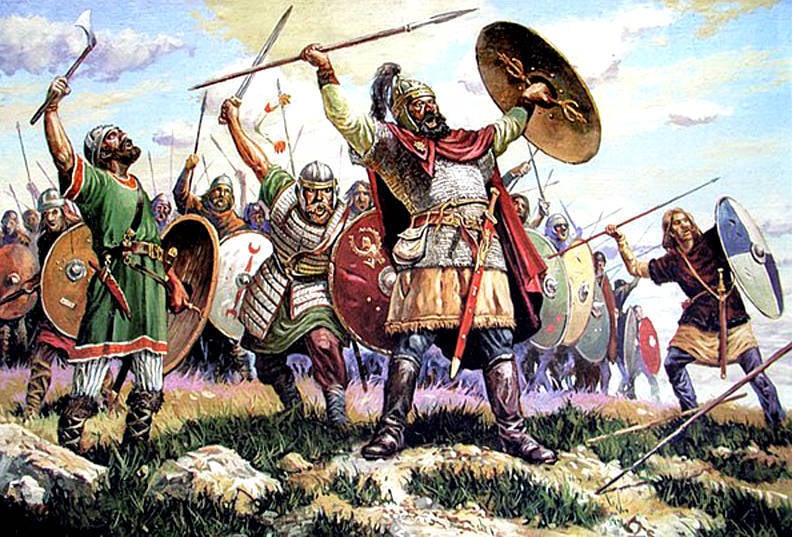
For the sake of restoring historical justice, it is worth paying attention to the events that took place in Crimea five centuries ago. Crimean Tatars, today positioning themselves as the indigenous people of the peninsula, then just began their journey on this blessed land. For almost three centuries, from the beginning of the 13th century to the turn of the 15th-16th centuries, the Orthodox principality of Theodoro existed on the territory of Crimea. Its glorious history and tragic end is better than any ranting by engaged politicians testify to the true fate of the indigenous inhabitants of the peninsula.
The uniqueness of the principality of Theodoro is that this small state in terms of size and population appeared on the ruins of the Byzantine Empire, which had fallen under the blows of Western European crusaders. That is, it belonged to the "Byzantine tradition", the official heir of which for all subsequent centuries was considered the Russian state with its fundamental idea "Moscow - Third Rome".
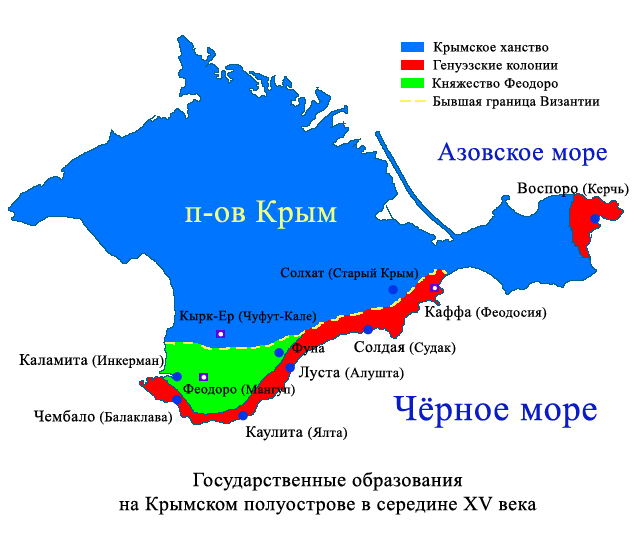
The history of Theodoro goes back to the very beginning of the XIII century, when the former Byzantine possessions in the Crimea were divided. Part of it fell under the power of the Genoese and became a colony of the Italian commercial city of Genoa flourishing at that time, while the part that managed to defend its independence and preserved the Orthodox faith was ruled by a princely dynasty of Greek origin. Historians still have not come to a single conclusion as to which particular dynasty the rulers of the state of Theodorites belonged to. It is known that in the veins of many of them the blood of such illustrious dynasties as the Comnenus and the Paleologs flowed.
Geographically, under the rule of the Theodorite dynasty were lands in the southern mountainous part of the Crimea peninsula. If you mark the territory of the principality on the modern map, it turns out that it stretched approximately from Balaklava and to Alushta. The center of the state has become the fortress city of Mangup, the ruins of which still delight tourists, remaining one of the most attractive routes for historical monuments of the mountainous Crimea. In fact, Mangup is one of the oldest medieval cities in Crimea. The first information about him falls on the V century AD, when he bore the name "Doros" and served as the main city of the Crimean Gothia. Already in those old times, several centuries before the baptism of Russia, Doros - the future Mangup was one of the centers of the Crimean Christianity. It was here in the VIII century that local Christians rebelled against the power of the Khazar Kaganate, who for some time managed to subjugate the mountainous regions of Crimea.
The uprising was led by Bishop John, subsequently canonized as St. John of Goths. By birth, John was a Greek - the grandson of a Byzantine soldier who moved to the Crimea from the coast of Asia Minor. From his youth he chose the path of a clergyman for himself, in 758 year, while in the Georgian territory, he was ordained a bishop and, returning home, headed the Diocese of Gothia. When a powerful anti-Khazar uprising occurred in 787 in the Crimea, the bishop took the most active part in it. However, the troops of the Kaganate, temporarily driven out of the mountainous areas, soon managed to prevail over the rebels. Bishop John was seized and thrown into prison, where he died four years later.
Remembering Bishop John, one cannot help but mention that he, in the midst of the confrontation between the iconoclasts and iconopaths, sided with the latter and contributed to the fact that from the territory of Asia Minor and other possessions of the Byzantine Empire on the southwest coast of the Crimea, iconopaths began to flow - priests and monks who created their monasteries and made an enormous contribution to the affirmation and development of Orthodox Christianity on the Crimean peninsula. Most of the famous cave monasteries in the mountainous Crimea were created by icon-worshipers.
In the 9th century, after the Khazar Kaganate finally lost its political influence in the mountainous part of the Crimean peninsula, the latter returned under the authority of the Byzantine emperors. Kherson, as the ancient Chersonesos was now called, became the location of the strategist who was managing the Byzantine possessions on the southern coast of Crimea. The first disintegration of the Byzantine Empire in the 12th century affected the life of the peninsula by the fact that it was in the sphere of influence of one of its three parts - Trapezunta, which controlled the central part of the southern Black Sea coast (now it is the Turkish city of Trabzon).
Numerous political upheavals in the life of the Byzantine Empire could not help but affect its real role in the management of the Crimean coast. Gradually based in Kherson, representatives of the imperial power — strategists, and then archons, lost real influence on the local feudal rulers. As a result, Mangup, now called Doros, and the princes of Theodorites reigned. Historians draw attention to the fact that even before the emergence of the principality of Theodoro, the Mangup rulers were wearing the title of a toparch. It is possible that one of them was the very toparch whom the Kiev prince took under his patronage (according to some data, Svyatoslav, according to others - Vladimir).
There is a version that the princely family of Theodoro belonged to the Byzantine aristocratic family of Havrasov. This ancient aristocratic family, in the X-XII centuries. ruled Trapezunt and surrounding territories, had Armenian origin. This is not surprising - after all, the “Great Armenia”, the eastern lands of the Byzantine Empire, were of great importance for the latter because they were at the forefront of the struggle with the eternal rivals of Constantinople — first the Persians, then the Arabs and the Seljuk Turks. Some historians believe that it was one of the representatives of the last name Gavrasov who was sent to Crimea by Trapezunt rulers as governor and, later, headed his own state.
The most famous representative of this family was Theodore Gavras. Without exaggeration, this man can be called a hero. In the 1071 year, when the Byzantine army suffered a crushing defeat from the Seljuk Turks, he was only a little more than twenty years old. However, the young aristocracy of Armenian descent managed to gather militia without the help of the Byzantine emperor and recapture Trapezon from the Seljuks. Naturally, he became the ruler of Trapezunta and the surrounding territories, and for about thirty years he led Byzantine troops in battles against the Seljuk sultans. The death of the warlord lurked shortly before he was fifty years old. In 1098, Theodore Gavras fell into a Seljuk captivity and was killed for refusing to accept the Muslim faith. Three centuries later, the Trabzon ruler was canonized by the Orthodox Church.
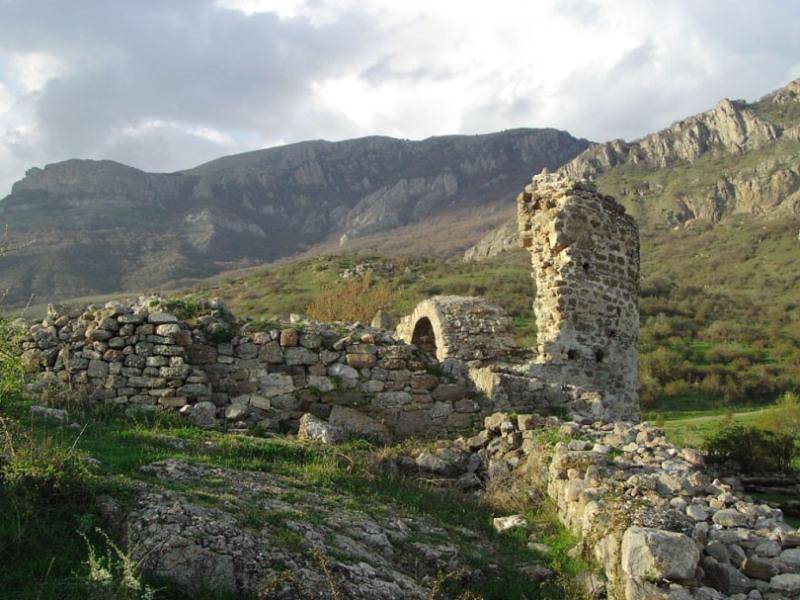
Fortress Funa
Representatives of the family Gavrasov, of course, were proud of their famous relative. Subsequently, the Trapezunt surname was divided into at least four branches. The first rule in Trabzon until the accession of the Komnins dynasty that replaced them. The second held important government positions in Constantinople. The third headed Koprivstitsu - feudal possession on the territory of Bulgaria, which existed until the end of the XVIII century. Finally, the fourth branch of Havrasov settled on the southwestern coast of the Crimea. Who knows - if they were destined to lead the state of Theodores?
Be that as it may, the establishment of political ties between Russia and the Crimean principality, with its capital in Mangup, goes back into those troubled times. Being a fragment of the Byzantine Empire, the principality of Theodoro played a rather important role in the system of dynastic ties of the Orthodox states of Eastern Europe and the Black Sea region. It is known that Princess Maria Mangupskaya (Paleolog), Stephen the Great's spouse, the ruler of Moldavia, came from the Theodorite ruling house. Another Mangup princess married David, heir to the throne of Trapezunt. Finally, Maria Mangupskaya’s sister Sophia Paleolog became the wife of Moscow’s Sovereign Ivan the Third.
The principality of Theodoro has its roots and several Russian noble families. So, at the end of the XIV century, part of the princely family of Gavrasov moved from Feodoro to Moscow, which gave rise to the old boyar Kovrin dynasty. For a long time it was this very Crimean family that was entrusted with the most important post of treasurer for the Moscow state. From the 16th century, two other notable Russian names, which played an important role in Russian history - the Golovins and the Tretyakovs, originated from the Khovrin family. Thus, both the role of the Theodorites in the development of Russian statehood and the historical presence of the “Russian world” on the southwestern coast of the Crimea peninsula are undeniable.
It should be noted that it was during the period of existence of the state of Theodorites that the southern coast of Crimea experienced a real economic and cultural flourishing. In fact, the rule of the Theodorite dynasty was comparable in its significance for the Crimea to the Renaissance in European states. After the rule of the Khazars and the long-term political turmoil caused by internal strife in the Byzantine Empire, two centuries of the existence of the principality of Theodoro brought long-awaited stability to the southwestern coast of Crimea.
It was during the period of the existence of the state of Theodoro, i.e. on XIII - XIVvv., it is the heyday of Orthodoxy and Orthodox statehood on the southwest coast of Crimea. Theodoro was a kind of center of Orthodoxy in the Crimea. There were many Orthodox churches and monasteries. After the conquest of the eastern part of Byzantium by the Seljuk Turks, monks from the famous Orthodox monasteries of mountain Cappadocia found refuge in the territory of the Crimean principality.
On the territory of the Crimea, including the settlements that were part of the principality of Theodoro, the Armenians of Anya, residents of the city of Ani and its environs, who were subjected to the destructive attack of the Seljuk Turks, also migrated en masse. The Armenian Armenians brought with them remarkable trade and handicraft traditions, opened the parishes of the Armenian Apostolic Church in many cities and towns of both the Genoese and the Theodorean parts of Crimea. Along with the Greeks, Alans and Goths, Armenians became one of the main components of the Christian population of the peninsula, remaining such after the final conquest of the Crimea by the Ottoman Turks and their vassal - the Crimean Khanate.
High degree of development differed agriculture - the basis of the economy of Theodore. Residents of the south-western Crimea have always been excellent gardeners, gardeners and winegrowers. Winemaking has received special distribution in the principality, becoming its calling card. The findings of archaeologists in the fortresses and monasteries of the former Theodoro testify to the high development of winemaking, since in almost every locality there were necessarily crushers for grapes and wine stores. As for crafts, Theodoro also provided himself with pottery, blacksmith and weaving products.
A high level of development in Feodoro reached the construction craft, thanks to the possession of which local craftsmen erected wonderful monuments of fortress, church-monastic and economic architecture. It was the Theodorite builders who built the fortifications, which for two centuries protected the principality from numerous external enemies, encroaching on its sovereignty.
During its heyday, the principality of Theodoro had at least 150 thousands of people. Almost all of them were Orthodox. In ethnic terms, the Crimean Goths, Greeks and descendants of the Alans prevailed, but Armenians, Russians and representatives of other Christian nations also lived in the territory of the principality. The Gothic dialect of the German language, which was preserved on the peninsula until the final dissolution of the Crimean Goths in other ethnic groups of the Crimea, was widespread in the principality.
It is noteworthy that Theodoro, despite the small size and small population, repeatedly fought off the superior enemy. Thus, the small mountain princedom could not take either the hordes of Nogai or the armies of Khan Edigei. Nevertheless, the Horde managed to gain a foothold in some areas, previously controlled by the Mangup princes.
The Christian principality on the southern coast of the Crimea, which was a fragment of the Byzantine Empire and kept in touch with the rest of the Orthodox world, was a bone in the throat for both Genoese Catholics who also created a number of strongholds on the coast and for the Crimean khans. However, it was not the Genoese and the Khans who put an end to the history of this amazing state. Although armed clashes with the Genoese happened more than once, and the rulers of the Crimean horde looked predatory towards the prosperous mountain state. The peninsula aroused interest and gaining strength in the southern overseas neighbor. Ottoman Turkey, which defeated and completely subdued the Byzantine Empire, now considered the former lands of Byzantium, including Crimea, as the territory of its potential expansion. The invasion of Ottoman troops on the Crimean peninsula contributed to the rapid establishment of the vassalage of the Crimean Khanate in relation to Ottoman Turkey. Armed by the Turks managed to overcome the resistance of the flourishing Genoese trading posts on the Crimean coast. It is clear that a similar fate awaited the last Christian state of the peninsula - the principality of Theodoro.
In 1475, Mangup was under siege by the many thousands of army Gedik Ahmed Pasha - commander of Ottoman Turkey, who, of course, was assisted by the vassals of Istanbul - the Crimean Tatars. Despite the repeated superiority of force over the Theodorites, the Ottomans could not take the fortified Mangup for five months, although they concentrated around the mountain fortress numerous military forces - almost all the select units that participated in the conquest of the Crimea.
In addition to the residents and the prince's squad, the city was defended by a detachment of Moldovan soldiers. Recall that the Moldovan ruler Stephen the Great was married to the Mangup princess Maria and had his tribal interests in the Crimean principality. Three hundred Moldovans, who arrived along with Prince Alexander, who recently occupied the throne of Mangup, became the “Three hundred Spartans” of Crimea. Theodorites and Moldovans managed to destroy the elite of the then Ottoman army - the Janissary Corps. However, the forces were too unequal.
In the end, Mangup fell. Unable to defeat the small forces of its defenders in direct combat, the Turks took the city into oblivion. Furious with many months of violent resistance from its inhabitants, the Ottomans destroyed half of its 15-thousand population, and the second part — mostly women and children — was enslaved to Turkey. In prison, Prince Alexander died - the last ruler of Theodoro, who managed to correct a very short time, but proved himself a great patriot and brave warrior. Other representatives of the ruling family also died there.
Having survived much more powerful Constantinople and Trapezunt, the small Crimean principality became the last bastion of the Byzantine Empire, which resisted the onslaught of the enemy to the end. Unfortunately, the memory of the heroism of the inhabitants of Mangup has hardly survived. Modern Russians, including the inhabitants of the Crimea, have little knowledge of the tragic history of a small mountainous principality and of daring and hardworking people who inhabited it.
For a long time after the fall of Theodoro in the territory that was once part of this principality, the Christian population lived. Greek, Armenian, Gothic cities and villages remained the breadbasket of the Crimean Khanate, since it was their inhabitants who continued the excellent traditions of horticulture and viticulture, sowed bread, were engaged in trade and crafts. When Catherine the Second decided to resettle the Christian population of Crimea in the Russian empire — first of all, Armenians and Greeks — it was a great blow to the economy of the Crimean Khanate and ultimately contributed to its destruction no less than direct military actions of the Russian troops. The descendants of the Crimean Christians, including the inhabitants of the principality of Theodoro, gave rise to two remarkable ethnic groups of Russia and Novorossia - the Don Armenians and the Azov Greeks. Each of these peoples made and continues to make a worthy contribution to Russian history.
When the current champions of the Ukrainian “separatism” talk about the indigenous and non-indigenous peoples of the peninsula, it is impossible not to remind them of the tragic history of the end of the last Orthodox principality in Crimea, to remind you of how the Crimean land was freed from its true indigenous people, who defended their home to the last your faith.
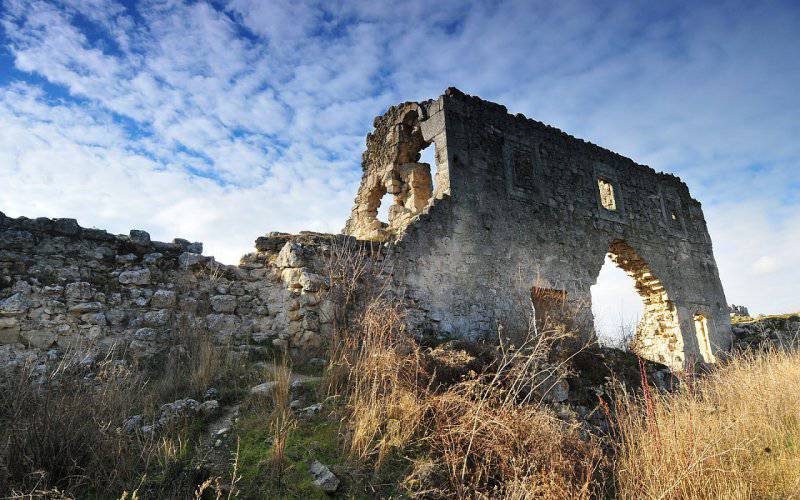
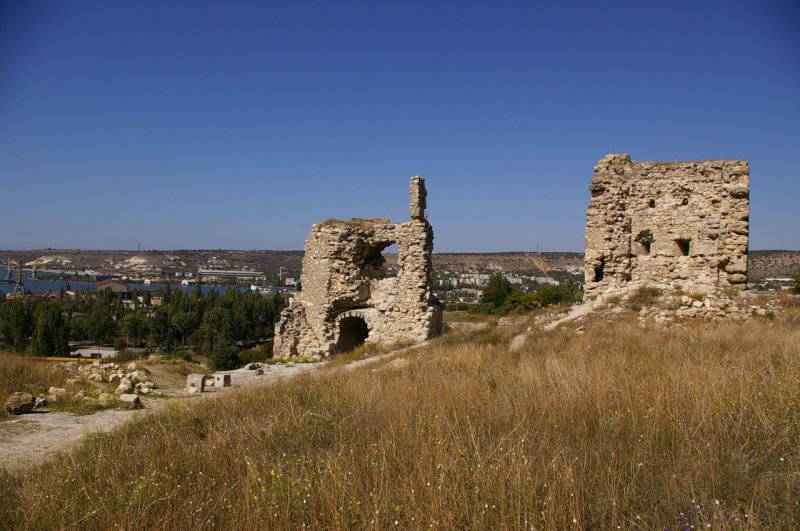
Information